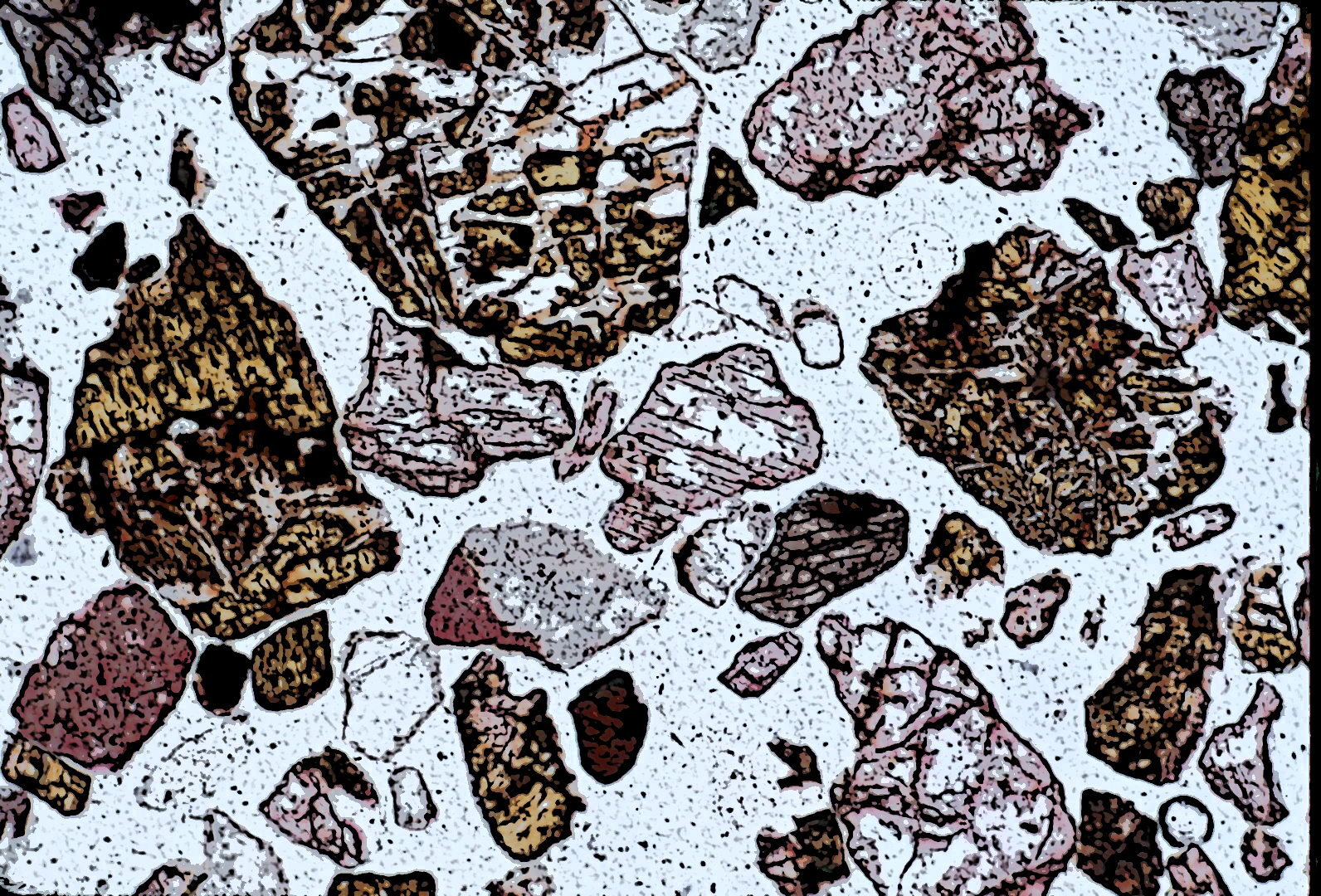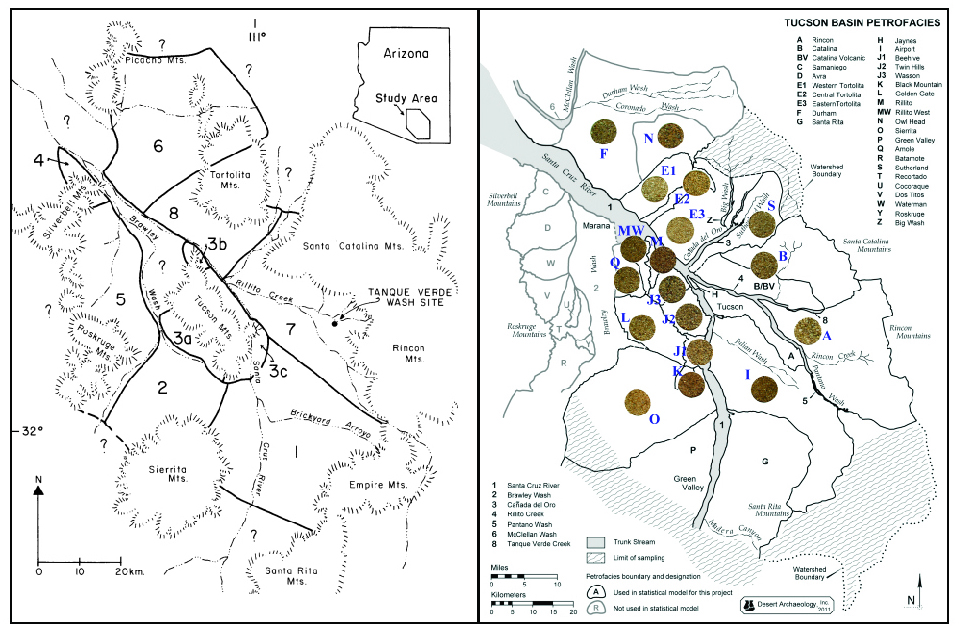
The Beginning of Hohokam Sand Temper Provenance Studies
This week’s blog is written by James Heidke, Desert Archaeology’s senior ceramic analyst. Douglas Craig, an outstanding Southwestern US archaeologist and former Desert Archaeology colleague, passed in mid-May 2020.
Most people who know Doug Craig’s professional reputation will think of him as a project director, and, indeed, I worked with him in that capacity throughout the 1980s and 1990s during the critical period when the Arizona Division of the Institute for American Research became Desert Archaeology, Inc. However, I first met Doug soon after I’d moved to Tucson, when he and Chris Downum led a tour of the archaeological site known as Cerro Prieto for University of Arizona graduate students, and I last saw Doug in 2018 leading another tour of the site for members of the Arizona Archaeological and Historical Society. While we drove to the site for the latter tour, Doug regaled those of us in the vehicle with a tale regarding his role in one of the more important developments to occur in Hohokam archaeology during the last 35 years. The presence of a trickster at the heart of the story lends it a somewhat mythic quality. Here I draw heavily upon Elizabeth Miksa’s published account of the story, as told to her by Doug in 2007 and recently verified by Jim Lombard…
During the summer of 1984 I was leading an excavation at the Dakota Wash site sponsored by Pima Community College. Jim Lombard was a member of the crew. At the time Jim was planning on doing his University of Arizona Geosciences Department M.A. thesis on something in the Sierra Pinacate, but over the course of the project he developed an interest in local Tucson Basin archaeology and the possibility of sourcing Hohokam ceramics through petrographic analysis. One of the things that opened his eyes to the potential was a prank that was pulled on me near the end of the project. Steve Troncone, another crew member who happened to be a very good potter, made a replica of a Hohokam effigy vessel and hid it in a cemetery area we were investigating. One of the ways we figured out it was a fake was when Jim noticed that the dirt inside the vessel—Steve had buried it in his backyard for a week—looked like it was from the eastern Tucson Basin, not the bajada of the Tucson Mountains where the Dakota Wash site was located. Needless to say, everyone was pretty jazzed by the possibility that pottery produced in different parts of the Tucson Basin could be identified archaeologically…
As early as the mid-1930s, ceramicist Anna Shepard had suggested collecting sand samples in order to characterize the range of variation in regionally available raw materials, but, before the epiphanal moment described above, archaeologists had only done so to a very limited extent in Jordan, Papua New Guinea, and the Lesser Antilles. Lombard’s M.A. thesis, based on 87 sand samples, represents the first comprehensive study of sand compositions conducted for archaeological provenance research (Figure 1, left). Subsequently, an additional 580 wash sand samples have been collected from the greater Tucson Basin. Their analysis provides irrefutable evidence that many spatially discrete sand temper compositions were available to Hohokam potters living in the area (Figure 1, right).

Figure 1. Left: The earliest Tucson Basin petrofacies map, prepared in 1986 by James Lombard for the Tanque Verde Wash report. Right: The current Tucson Basin petrofacies map, based on petrographic and statistical analyses of 296 sand samples, prepared in 2012 by Elizabeth Miksa, Mary Ownby, and Carlos Lavayen for the Honey Bee Village report. Representative examples of sand from each petrofacies were added and formatted by James Heidke and Mary Ownby in 2018 (click to enlarge).
Importantly, those compositions can be documented with the aid of a low-power, reflected-light microscope, as well as a petrographic microscope, such as the one Lombard used. Doing so allows the composition and provenance of many more sherds to be characterized than would be practical to analyze by petrographic methods alone, yielding accurate estimates of the proportions of pottery from various locations.
For example, provenance data from hundreds of Middle Rincon phase (ca. AD 1000-1100) sherds have been recorded using a binocular microscope and verified petrographically. Three villages—West Branch, Julian Wash, and Valencia—are located within 3 km of the Beehive Petrofacies (Figure 2, left). Those communities all appear to have specialized in pottery production, as one-third of the ground stone tools recovered from excavations at them were used in making pots, and pottery tempered with Beehive Petrofacies sand was distributed widely throughout the basin (Figure 2 right). Pottery made in other villages has only been found near the locations where it was made, and pottery-making tools comprise less than five percent of the ground stone tools there.

Figure 2. Left: Detail of the current Tucson Basin petrofacies map, showing the location of the West Branch, Julian Wash, and Valencia sites. Each site is surrounded by a circle with a 3-km radius denoting the potential catchment area for local temper resources based on ethnographic data. Right: Schematic representation of Middle Rincon phase ceramic production and distribution patterns (click to enlarge).
Interestingly, an unusually large percentage of the pottery from the Hodges Ruin is tempered with Beehive Petrofacies sand. A secondary peak in abundance is a characteristic of places where redistribution occurred. The importance of the Hodges Ruin in the Tucson Basin’s local system is attested to by the fact that its ballcourt shares the same orientation as Ball Court 1 at Snaketown (on the Gila River south of Phoenix) and is nearly identical in length. The location of the Hodges Ruin near the confluence of the Santa Cruz River, Rillito Creek, and the Cañada del Oro would have facilitated the distribution of pottery (produced at West Branch, Julian Wash, and Valencia) into the eastern and northeastern basin, following the natural corridors formed by Rillito Creek and Cañada del Oro Wash. Ethnoarchaeological studies of pottery manufacture and distribution suggest residents of the Hodges Ruin may have acquired vessels directly from potters and then bartered or gifted them to other consumers who had no relationship with the potters, or that the potters may have used contacts in the village to store and distribute pottery on their behalf.
The composer Franz Liszt noted that Beethoven began his career by modeling his music on that of earlier composers but then arrived at musical inventions requiring entirely new means of expression, styles, and forms. Much the same could be said regarding Hohokam ceramic studies. Prior to the invention of petrofacies-based provenance studies, archaeologists focused their attention on pottery typology and dating. However, a prank and a sharp-eyed archaeologist initiated new avenues for exploration involving not only production locations (and the nature of distribution from those places), but also studies of technological and decorative variation within ceramic types made at different locations, and variability in container function related to locus of manufacture and consumer preference or choice. While sand temper provenance studies originated in the Tucson Basin, petrofacies models have been constructed for many other parts of southeastern Arizona, the Flagstaff area, the Angelina River Basin of east Texas, and a portion of northern Sonora, Mexico. Further, some of the computational methods developed in consort with the analyses have been adopted by geologists and published in journals such as Aeolian Research and the Marine Pollution Bulletin. All in all, quite a large impact from so simple—yet profound—an observation one summer day.
Resources
Additional information on petrofacies research by Desert Archaeology’s James M. Heidke and Dr. Mary F. Ownby can be found in previous Field Journal posts:
Hohokam Ceramic Studies: Past, Present, Future
Petrography and Archaeology: Microscopic Fun with Pottery
The referenced passage from Elizabeth Miksa is published in: Miksa, Elizabeth J., 2011. Half Million Points and Counting: Two Decades of Petrofacies Modeling in the Greater Tucson Basin and Avra Valley. In Craft Specialization in the Southern Tucson Basin: Archaeological Excavations at the Julian Wash Site, AZ BB:13:17 (ASM): Part 2. Synthetic Studies, edited by H. D. Wallace, pp. 553-617. Anthropological Papers No. 40. Center for Desert Archaeology, Tucson.


